Canister vacuums are a bit retro, and that fits the design aesthetic of the Prolux Tritan perfectly. However, the performance specs are anything but old-school. Read on to see how this canister vacuum performed against our battery of tests.
HEPA Filtered Canister Vacuum
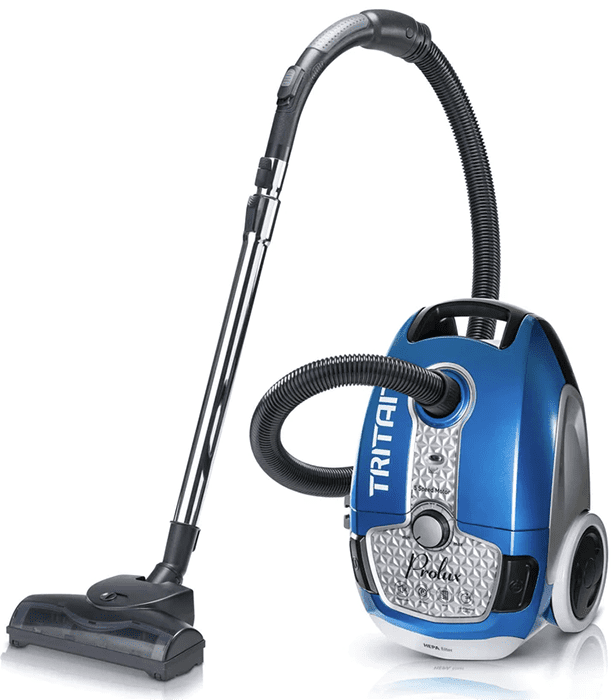
Prolux Tritan Canister Vacuum
The Prolux Tritan is a corded, canister vacuum that performed extremely well in our tests. The one major drawback we saw was a consistent problem with debris falling out of the brush head after the vacuum was powered off. This was a minor, but noticeable amount of debris. Other than that, the Prolux Tritan handled each floor type and each hair type excellently. It’s a little noisy on the lowest setting, but it is easy to use and lightweight. Overall, I think it is an excellent general-purpose vacuum for the home.
Pros
- Fantastic overall performance during our tests
- Easy to operate even though it has a canister and power cord
- Great accessories that clip onto the wand for easy accessibility
Cons
- Debris sometimes gets stuck in the brush head only to fall out after turning power off.
- You have to be mindful of the canister and cord
- You will need to buy replacement dust bags
Scoring
Excellent value for all-around performance
-
Design - 93%
93%
-
Performance - 96%
96%
-
Quality - 95%
95%
-
Usability - 96%
96%
-
Value - 96%
96%
Summary
The Prolux Tritan is an older design that has corded power, a larger canister, and wheels to roll around. It still feels lightweight and is notably stylish in a retro way. Performance was excellent across all surfaces and debris types. At only a couple hundred dollars, a vacuum this versatile and high performing is worth a look.
In This Review
Cleaning Test | Long Hair Test | Pet Hair Test | Noise Test | Usability | Accessories | Size | Specs | Summary
Performance Tests
At Modern Castle, we use 6 different tests to measure the cleaning performance and usability of stick vacuums.
These tests include:
- Cleaning test
- Hair test
- Pet hair test
- Noise test
- Usability test
Cleaning Test
To test cleaning performance of the Prolux Tritan, we use 4 different debris types (sugar, kitty litter, rice, and cereal) on 3 different floor types (hardwood, low pile carpet, and high pile carpet).

We then use the vacuum on the max suction power and clean up the debris. After which, we check how much of the debris was removed by weight.
Overall
98.4%
Hardwood
99.3%
Low Carpet
98.2%
High Carpet
97.9%
Cleaning performance was great on all floor types and with all debris. This did require using the correct brush head for the floor it was cleaning. Hardwood is meant to use the multi-surface floor tool and the carpets were best with the spinning brush roll tool.
Hardwood Floor Cleaning
Originally we attempted to clean the hardwood floor with the spinning brush roll tool and the results were abysmal. Debris mostly stayed around the brush head without getting sucked up. After consulting the Prolux website, we determined the spinning brush tool was best used on carpet and the multi-surface tool was for hardwood.
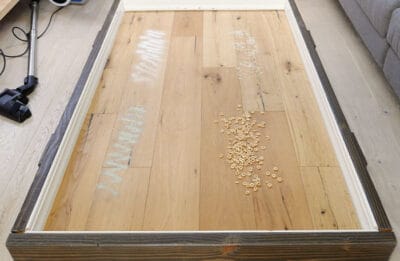

When we re-ran the tests with the multi-surface floor tool, results were stellar. Virtually all debris was removed by the Prolux Tritan. We use 99% to signify that there was no measurable weight (in oz) of debris left behind, but visually, we saw a minuscule amount was left behind. With cereal it is clear that 100% was picked up by the vacuum.
Sugar
99%
Kitty Litter
99%
Rice
99%
Cereal
100%
Low Pile Carpet Cleaning
This is where we switched to the spinning brush roll tool, as it is best on carpets. The active spinning brushroll is quite powerful and took some getting used to. There is some control needed to keep the brush head from “running forward” without it stopping in place.
Sugar
97.2%
Kitty Litter
98.1%
Rice
98.5%
Cereal
99%
When we found the right balance, the results were excellent. Although, they were less than perfect. Smaller debris like sugar and kitty litter left tiny, but measurable amounts behind, with the Tritan removing 97.2% and 98.1%, respectively. Cereal and rice fared better, but about 1.5% of the rice remained on our testing lane after running the vacuum.
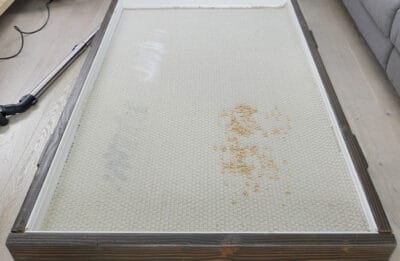

Note: With all tests using the spinning brush roll tool, debris fell out afterward. It would take a few seconds after turning power off to the vacuum, but some amount always came out. This amount is what we weighed at the end of our tests.
I can only speculate where the debris is getting stuck. It would be best to keep the hose as straight as possible and let the vacuum run a bit after engaging large concentrations of debris.
High Pile Carpet Cleaning
High pile carpet showed the worst performance on the Prolux Tritan. But even its worst is fantastic. Sugar and cereal saw a removal of 99% with kitty litter very close behind at 98.8%.
Sugar
99%
Kitty Litter
99%
Rice
99%
Cereal
99%
Rice on high pile carpet is what challenged the Tritan the most during our tests. At a removal of 94.6%, a notable amount of rice was able to escape the vacuum after power was turned off.


Even with scores as good as we see here, this propensity for debris falling from the Tritan post-use is troubling, even if the amounts are small. Again, we only saw this occur with the spinning brush roll tool.
Long Hair Test
For our hair test, we place strands of hair in the direct cleaning path of the vacuum. We then run the vacuum over it and check to see how much hair was removed, and if any tangled in the brushroll. Because we run this test on high pile carpet, we used the spinning brush roll tool.
Removed?
100%
Tangled?
Moderate
After running the Tritan over the hair, we found that it was able to remove 100% of the long strands, but there was a moderate amount of tangling in the brushroll. Over time, this would surely be a problem. However, the box came with a hair-cutting tool for just this purpose.

We will discuss this process further under maintenance.
Pet Hair Test
Our pet hair test is similar to the long hair test, in that we place pet fur in the direct cleaning path of the vacuum, run the vacuum over it, and see how much is removed. For this test, we placed the pet hair on high pile carpet and ran the Prolux Tritan on the maximum setting.
For pet hair, the Tritan showed great results. After only one semi-slow pass, all the ground pet hair was picked up. We then examined the brush head to see if any hair lingered inside.
Removed?
100%
Cleaning Passes?
Two
We found a fair amount stuck within the crevices of the spinning brush roll tool. There is a back compartment that is accessible via a removable panel. This revealed a hidden cache of pet hair.

This affects our assessment of the Tritan with regard to pet hair performance, but its overall ability to remove it from the carpet was still excellent.
Noise Test
To test the noise of the Prolux Tritan, we run the vacuum on high pile carpet on the different power modes and measure the amount of noise generated with a sound meter from about 3’ away.
Lowest Setting
60.5 dB
Highest Setting
65.5 dB
In terms of sound, there didn’t seem to be a large difference between the highest power setting and the lowest. Considering the max decibel level measured for each, there was only a 5-decibel difference between the two.

This decibel level is about equivalent to normal conversation or a dishwasher running according to the below chart.
Common noise levels:
- 20 dB – rustling leaves
- 30 dB – whisper
- 40 dB – quiet library, babbling brook
- 50 dB – refrigerator, moderate rainfall
- 60 dB – normal conversation, dishwashers
- 70 dB – traffic, showers
- 80 dB – alarm clock, telephone dial tone
Usability
I found usability on the Prolux Tritan to be excellent. Setup was simple, if not a bit longer than average. The controls felt initiative and maintenance was straightforward. There are a lot of little touches to the design that makes the Tritan feel ergonomic and well-thought-out.


Here is what comes in the box:
- Prolux Tritan canister
- Extendable metal wand
- Spinning brush roll tool
- Multi-surface floor tool
- On board tool caddy
- Pivotable duster brush
- Upholstery tool
- Crevice duster tool
- Replacement micron bags (x6)
- Plastic hose with handle
The accessories all fit somewhere on the assembled vacuum. Not having to worry about a bag of accessories that could get lost is a benefit of this design. However, the replacement bags and hair-cutting tool will need to be stored elsewhere.

Every connection point snaps, clicks, or is otherwise purposefully locked in place. There are buttons or release levers for each one. On top of that, they all feel well-made and easy to use. With one exception.
My only gripe with the usability on the Prolux Tritan is where the metal wand connects to the brush heads. To push them far enough to reach the intended depth made the connection far too tight when attempting to remove.
Even with pushing quite hard on the release button, it required an uncomfortable amount of force to separate. A silicon ring on this part of the metal wand started moving around after only a dozen uses.
Setup
Setup was extremely easy, and it took about 5 – 10 minutes to understand where everything goes to turn on the vacuum. These steps include:
- Place micron bag inside
- Attach back of hose to canister
- Attach handle of hose to metal wand
- Attach metal wand to desired brush head
- Place unselected brush head on side of canister where the grooves met
- Assemble accessories on the tool caddy and snap that on the wand

Controls & Display
There are only a handful of controls on the Prolux Tritan. From the canister, you can control the following:
- Knob for speed
- Power Button
- Retract power cord
- Various sliders on hose, wand, and brush head
The attachments have various small adjusting sliders and brushes to customize the suction input or performance for specific surfaces.


Maintenance
Maintenance is simple on the Tritan. It can be split into 3 considerations:
- Replace dust bag
- Rinse motor filter
- Wash or replace HEPA filter
Dust bags have a capacity of 4.5 liters. This is pretty good, but the Tritan only comes with 6 replacement bags. After this time, you will need to purchase more.
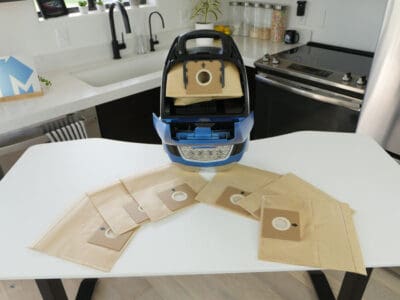

There is also an indicator light that will turn red telling you it is time to replace the bag.
The motor filter, accessible via the compartment with the dust bag, should be rinsed once a year.


The HEPA filter is located on the underside of the canister and should be washed or replaced. The frequency is not specified by Prolux.
I found locating each of these parts and accessing them to be extremely easy and straightforward.
Attachments & Accessories
The Prolux Tritan comes with 2 primary brush heads and 3 smaller accessories.
The exact names for each are:
- Spinning brush roll tool
- Multi-Surface floor tool
- Pivotable duster brush
- Upholstery brush
- Crevice duster tool
We’ve already discussed our experience with the two brush heads. In our experience, the multi-surface tool was better for all debris types on hardwood floors. The Spinning brush roll tool was excellent for all carpeted surfaces.

These other tools are the common types you’ll find with most vacuums. They all fit and seem like a step above the standard version for these tools. The crevice tool, for example, has a built-in angled brush attachment to aid in difficult crevices.


These 3 accessories can be attached to a caddy which is designed to clip onto the wand for easy access.
Size & Dimensions
The Prolux Tritan, being a canister vacuum, has two parts to consider for its size – the canister itself and the reach of the hose + wand + brush head.
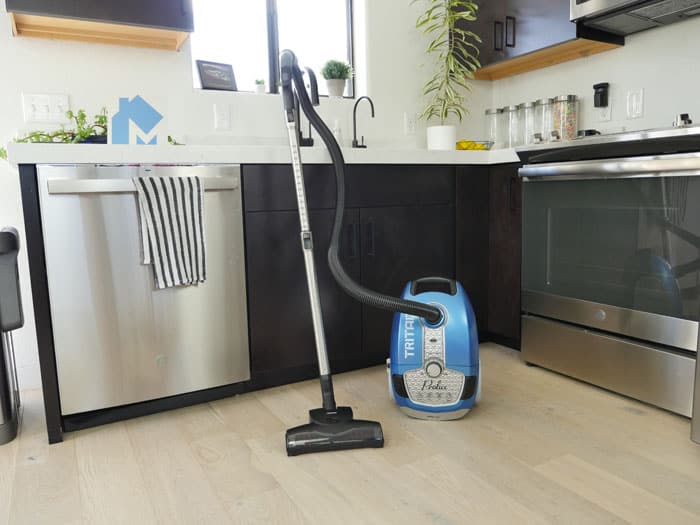
Here are the dimensions of the Prolux Tritan:
- Width – 10.24″
- Depth – 9.66″
- Height – 46.26″
- Weight – 8.68 lbs
The canister itself has a rounded shape but can generally be measured as 19” tall, 12” wide, and 10” deep if oriented with the handle facing up.
The hose and wand connect to make a length of roughly 10’.
Prolux Tritan Canister Vacuum Specifications
| Specifications | |
|---|---|
| Type | Canister |
| Manufacturer | Prolux |
| Model | Tritan |
| Height | 19” |
| Width | 12” |
| Length | 10” |
| Floor Type | All |
| Dust Bag Capacity | 4.5 L |
| Cord Length | 30 feet |
| Suction Power | 140 CFM |
| Cordless | No |
| Bagless | No |
| Returns | Varies by retailer |
| Warranty | 5 Years |
| Price | Check Price |
Should you buy the Prolux Tritan Canister Vacuum?
I would recommend the Prolux Tritan if you are looking for the following features:
- Powerful suction: During our performance tests, the power of the Tritan was evident in the results but also its feel while vacuuming. The extra power means it’s a little more important to choose the right brush head or accessory as the suction may be too much in some scenarios. At the end of the day, the Tritan is going to give you excellent suction power.
- Extremely ergonomic: The overall feel of using the vacuum along with the little features throughout the accessories left a positive impression on me. Nothing feels cheap or hastily added. All pieces snap into place with obvious thoughtfulness in the design. Finally, I liked the handle on the hose a lot.
- Lightweight and easy to maneuver: While it is a canister vacuum, it only weighs 15 lbs. It has both large wheels and a handle to make changing cleaning areas easy. That paired with the long hose and wand gives you a 32 foot cleaning radius from cord to brush head. And it has a power cord that retracts to the canister with a press of a button.
For more information or to buy the Prolux Tritan, click here.
